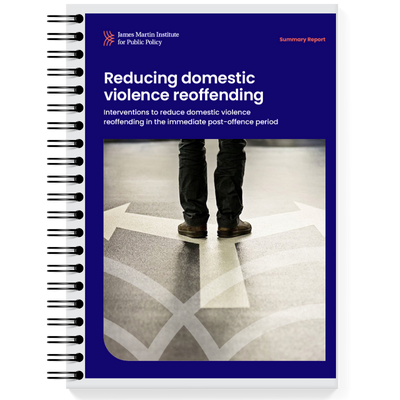About this report
The James Martin Institute worked with colleagues from the NSW Government and a panel of expert advisors to develop a research report on perpetrator interventions aimed at reducing domestic violence reoffending in the period immediately following (up to three months) an initial offence. This research sought to identify potential, evidence-based options for the NSW to broaden its initiatives to address domestic violence reoffending in this critical period. This involved providing an evidence base of jurisdictional case studies (Victoria, Queensland, New Zealand, and Scotland), outlining examples of services and programs, and synthesising existing research, with a specific focus on perpetrator interventions. The research specifically excluded consideration of any existing programs and responses in NSW. The report provided a detailed set of considerations for policy and practice in engaging domestic violence perpetrators in the immediate postoffence period and deterring them from reoffending.
This paper provides a short summary of the project’s key research findings.
Responses to domestic violence must continue to protect victim-survivors from harm while establishing accountability for perpetrators. While it is vital that perpetrator-focused interventions are improved, the paramount consideration guiding policy and practice must be the safety and well-being of victim-survivors. Working with domestic violence perpetrators to hold them to account for their behaviour should not detract from this objective and the ongoing need to ensure support, protection, and empowerment of victim-survivors.
The challenge
Reducing the number of domestic violence reoffenders by 25 per cent by 2023, based on a 2015 baseline, is a NSW Premier’s Priority. Preventing domestic violence entirely is a long-term aspiration: victim-survivors must be protected; perpetrators must be held to account. An important step towards achieving that long-term goal is to reduce domestic violence reoffending.
A significant portion of reoffending currently occurs in a relatively short period of time after an initial offence is recorded. Yet, it is precisely during this window – prior to conviction – that suitable interventions are difficult to configure and execute. There are limited options for accountability for perpetrators before trial and most men’s behaviour change programs are not geared towards managing short-term risks.
There are limited sources of evidence regarding the effectiveness of discrete interventions within the first three months following an initial offence. However, there are principles that can be drawn from the literature and the case studies to inform perpetrator interventions in this period.
A multi-faceted approach is needed that engages with the concrete needs and circumstances of the perpetrator in order to build their accountability for their choices to use violence, while mitigating the risks of further harm. The approach taken here is premised on the value of a holistic, human-centric approach that is responsive to the needs of specific perpetrators in their own circumstances that will enhance their accountability and improve the well-being and safety of victim-survivors. There are strong grounds for adopting this approach based on wider experience of effective public policy, and social policy in particular. The system must act quickly to deter further violence and build perpetrators’ sense of accountability.
Perpetrators must be seen as unique individuals with diverse characteristics and numerous factors exacerbating their choices to use violence. Their circumstances (and those of their victim and family) need to be quickly assessed by a range of relevant stakeholders – justice workers, service providers, social workers, community representatives – to understand their needs.
The perpetrator might need help to navigate a complex legal and service system. A key barrier, however, is that many perpetrators are unwilling to accept their wrongdoing, and, before a conviction, authorities have limited means to compel them to engage in programs. The system needs to find ways to motivate perpetrators to seek help. A system designed and delivered with the community in which a perpetrator lives would likely help. Leveraging other factors, especially the perpetrator’s desire to be a better parent, can be effective.
Any effective response to individual perpetrators, including by recognising their familial and social context, would benefit from the empowerment of those practitioners and community representatives who engage directly with perpetrators and can best understand their needs and tailor responses to those needs in a manner that will enhance accountability. System-level investments should therefore be especially alert to the opportunities of harnessing the capabilities and relational judgements of social workers and community representatives as they engage with perpetrators and those affected by their behaviour.
A multi-faceted response based on need
Our findings can be summarised under five key considerations for designing programs to reduce reoffending in the immediate post-offence period:
The services and programs
Given the intertwined challenges of perpetrators needing bespoke responses, practitioners needing flexibility to deliver tailored services, and the extensive waitlists and delays in accessing such programs, developing interim or bridging programs that can immediately accommodate new perpetrators would likely be beneficial.
If perpetrators pose a higher risk for reoffending, monitoring or deterrence programs might help by consistently reinforcing their accountability and reminding them of the consequences of further violence.
Accommodation support for perpetrators can help physically separate perpetrators from victim-survivors, while also providing an environment conducive to wraparound services.
Men’s behaviour change programs – or alternatives such as individual counselling – could play a constructive role in the immediate post-offence period. However, there is a lack of robust evidence that such programs can change behaviour in the short term to deter further violence. These activities could be adapted and leveraged during the immediate post-offence period to achieve short-term harm reduction and hold perpetrators to account as part of a broader strategy.
Given that many perpetrators have comorbidities that influence their violent behaviour, general human services (social assistance services) – like drug and/or alcohol therapy or mental health support – can help alleviate those stressors.
Services for victim-survivors (including children) and child services need to be connected into these perpetrator interventions, to help ensure their interests are reflected and the perpetrator is kept in view.
Towards better outcomes
There is no response that can guarantee that any one perpetrator will not reoffend. A system that quickly, meaningfully, and holistically builds the perpetrator’s sense of accountability and that addresses the factors that exacerbate their choice to use violence will, however, give victim-survivors a better chance of living free of further violence before perpetrators go to trial.
Going forward, it will be important to remain attentive to the particular circumstances on the ground, craft programs in that light, explore new approaches, rigorously monitor results, and iterate and scale up investments based on what is being learnt.
Key considerations
Services and programs
Overarching considerations applying to the whole system of perpetrator referral pathways, mechanisms, services and programs.
Referral pathways and mechanisms for perpetrators
Perpetrator services and programs



